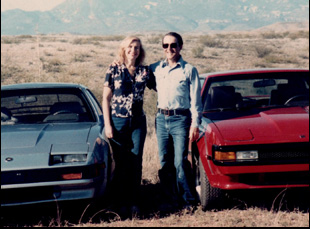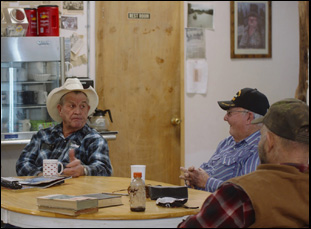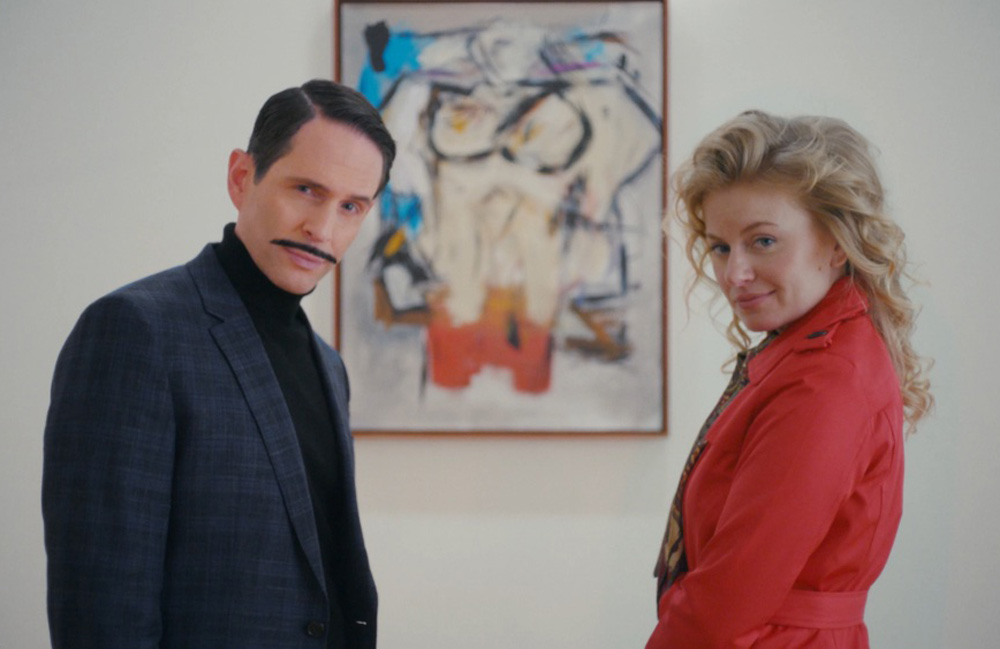Jerry and Rita Alter had a nail protruding from the foot of the door entering their bedroom to make sure it didn’t hit the wall in the right corner where amidst a collection of your usual tchotchkes and personal ephemera accrued over the years, there hung Willem de Kooning’s 1955 oil painting “Woman-Ochre,” considered one of the abstract expressionist artist’s most defining works. It wasn’t meant to be seen by anyone but the couple after they peeled it off the wall of the University of Arizona Museum of Art in 1985 at a time when there were no docents or cameras around to catch them in the act, and it almost wasn’t picked up on years later after they passed and a collection crew from Manzanita Ridge Antiques, beckoned by the executor of their estate Ron Roseman, nearly missed it as they evaluated the other items in their home in Cliff, New Mexico. No art experts, the team from Manzanita Ridge was incredulous to hear someone offer $200,000 for it on the spot after seeing de Kooning’s signature on the painting when it sat in their shop, waiting for a more professional appraisal, only to learn that it was worth far, far more.
With “Woman-Ochre” now resting safely once again at the U of A, director Allison Otto smartly dispenses with the least interesting part of the Alters’ story almost immediately in her delicious feature debut “The Thief Collector,” reconstituting the adventures of the mild-mannered couple thought to have lived a quiet life in the desert with a passing interest in art. While Jerry painted and played clarinet and the two traveled the world on a budget, one wouldn’t expect the couple to take their thrill-seeking to another level by stealing what they could not afford in their retirement, leading Otto to interview bewildered relatives and friends who try to reconcile what they did with the couple they knew as well as piecing together a story from the 12,000 slides and hours of 8 mm footage that the Alters’ took on vacations to see what they might’ve been hinting at just beyond the frame. However, Otto may have had no greater resource than “The Cup and the Lip,” a book of short stories that Jerry had self-published, treading the line between fiction and thinly veiled confessions to a life of nonviolent crimes as it recounted fanciful tales of globe-trotting exploits and the filmmaker gives them new life, casting Glenn Howerton and Sarah Minnich in the roles the Alters always imagined themselves in than the ones they were assigned.
Following the trek of de Kooning’s painting from the artist’s studio in New York to its eventual restoration at the Getty Museum in Los Angeles, “The Thief Collector” also considers the relative value of art, clearly appreciated by the Alters even as if they deprived the rest of the world from seeing “Woman-Ochre” in person for a time and when everyone weighs their culpability, they are also taking into account what they think they think the worth of the painting is as art experts throw around numbers in the hundreds of millions and average people in the Alters’ orbit wouldn’t even know if they’d pay a few bucks at a thrift store for it. No matter what its value is, Otto makes something priceless with the witty true crime story and after premiering last year at SXSW, “The Thief Collector” is making its way to theaters and VOD this week and we recently were able to steal some time with the director to talk about crafting the caper, literally finding the best light to portray the film’s subjects and making a stranger than fiction tale to believe in.
I first found out about the story back in 2017 on the Smithsonian Web site, and the story just haunted me. At the time, I was doing freelance work for the BBC and when they put out a call for true crime stories, several months had passed, but I immediately thought of this particular story, so I decided to revisit it and reach out to the [Alters’] nephew, the executor of the estate, who you see in the film and as soon as I started talking to him, I realized the theft itself was really just the tip of this iceberg into this couple, so it was not a short journalism piece. There was much more there.
What was it like actually meeting Ron, the nephew who is in this peculiar position of being part of the family but learning about them through you in a way?
Yeah, he’s a sweetheart and I think it was in Variety [where] the reviewer called him like a genially perplexed mensch because he’s such a good guy and when I started chatting with him I believe in 2018, he was still on the fence about whether or not they had committed this crime. He was actually thinking that perhaps they had acquired the painting at some yard sale or in a back alley purchase because they were art collectors, so he was hopeful that was the scenario, or was open to the possibility of that and of course, that shifted as we as we interviewed him over time and and [we] just followed his trajectory in terms of the way he thought about it.
Is it true you didn’t know about the existence of the book Jerry wrote until midway through filming?
No, I knew about the book, and that one of the stories was very similar to the theft, but I didn’t know that all of these other life experiences so closely mirrored the [Alters’ real-life] story or the mystery of the septic tank — I didn’t know about that until about three quarters of the way through filming, and it was actually during an on-camera interview that I first learned about that, and my [thought] going through my head was, “Oh my God, is this film about to take a hard left” because it was really a shock to me. So it wasn’t until halfway through that I really wanted to bring Jerry’s stories into the film and adapt excerpts of them [in a style] that was very Wes Anderson, Coen Brothers-esque because that the book of stories were so poorly written they’re like a drugstore novel kind of a thing, but they really gave all this psychological insight into his mind and how he viewed himself. So many of the stories [have] protagonists that are basically avatars of he and his wife, so when I started to realize that, and that the stories really [became] his voice from beyond the grave, that was when I started to really think about how we could adapt these excerpts of these stories in a really unique way.

With the sections of Jerry’s stories that are woven into the film, I think of those more as like adaptations than reenactments because there’s a clear difference between how Jerry wrote about the theft in his book of short stories, where he and his wife are these smooth criminals and [and the stories are] very “Mission Impossible”-esque, but then you hear about the real theft and how the thieves were bumbling their way through this crime. It wasn’t smoothly executed. It was very stumbly bumbly and they wore drugstore-type of costumes. The mustache itself was very fake looking, as the professor [who was a witness mentions] and when he first saw it, but he didn’t want to offend Jerry, but at the time he didn’t know that Jerry was the thief, so the professor didn’t say anything at the time or think anything of it, but now it’s an example of how stumbly bumbly the whole thing was.
It seems like you pulled off a coup of your own when you’re there to actually see the de Kooning painting restored. Was that naturally part of the timeline for this film?
Yeah, we were able to film the restoration of the painting. Shortly after it arrived there at the [Getty Museum], we were able to film there for a day and then COVID happened, so we weren’t able to film [any more], but the restoration was still in progress and was being filmed by their in-house cinematographer, so we were able to use that footage. But when I did see the painting for the first time at the very beginning of its restoration, it was in bad shape and the people that restore these paintings are like surgeons. A painting is brought into their operating room, so to speak, and this one was on life support and it needed a lot of work. For instance, this is mentioned in the film, but you can see where Jerry had stapled the painting to a very cheap backing, and then put it in a tacky frame and then there had also been some amateur touch-ups that had been done by Jerry with this Hobby Lobby-type of paint and there were all the cracks that had happened as a result of the painting being rolled up when it was stolen from the museum and stuffed it in his jacket.

I’ll have to tell the cinematographer because we thought about that a ton. Casual viewers don’t often consciously tune in on that, but we wanted the framing to be abstract in the way an expressionist painting is, but in the background you can sometimes see these little pops of color that were taken from the painting itself. We matched the gels that were put over the light to the colors in the [De Kooning] painting because we wanted people subconsciously to be reminded of the painting and then the guy in the car, we purposely did that because he lives in that van, so we thought it played into the story and into his personality as a whole to see that might have been where the painting would have gone had he purchased it. He was a wonderful guy and a really quirky character.
What’s it been like to get this out into the world?
This was my first feature-length documentary and we premiered it at South by Southwest. It was the first time I’d been there, and that is just a massive festive and we’ve had so many sold out screenings [since]. People have come up to me afterwards and enjoyed the film and to know that it resonated with them after all the work we put put into it really makes me so happy. I think the story itself is so fascinating and for other people to feel that as well and to be one of those water cooler films that people keep thinking about and talking about that just makes me feel so wonderful.
“The Thief Collector” opens on May 19th in theaters and is available on digital.





